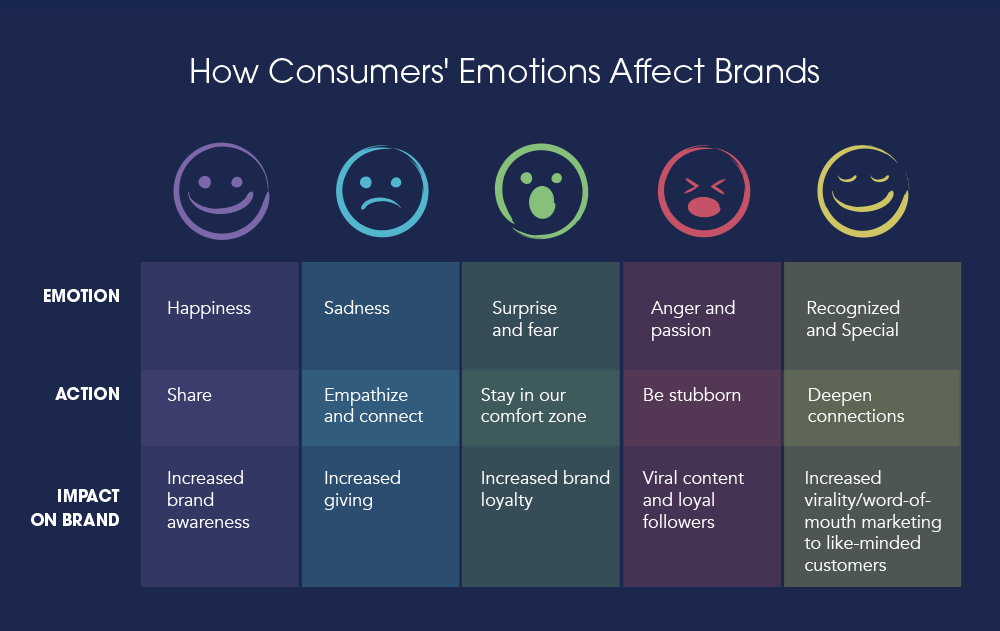“The thrill of victory, and the agony of defeat.” This classic line in ABC’s Wide World of Sports opener promised viewers an emotional roller coaster as they watched the “human drama of athletic competition” unfold.
These kinds of visceral experiences are at the heart of emotional marketing, a strategy brands use to connect with their audience in a deeply personal way. There’s a brilliant MetLife commercial featuring a loving father who shields his little girl from their financial hardships. AdWeek called it a “father-daughter story that digs deeper, and packs even more of an emotional wallop, than similar ads of late.”
Brands that understand the true definition of emotional marketing and what emotional advertising is do more than evoke feelings, however. They inspire customers to buy, subscribe, like, share, or give.
Exploring the Emotions
Psychological research suggests we have two distinct ways of thinking and making decisions: rational and emotional. When it comes to marketing, brands often appeal to the rational mind—give consumers the facts, and they will make a decision on its merits.
In reality, most decisions are made using our emotions or instincts. These structures in the “old brain”—the instinctual parts that regulated our survival—are typically the first to process information and are thus the most powerful to activate.
In fact, we process emotions in one-fifth the time we do rational thought. To generate interest, then, brands can appeal to the emotional mind and save the facts for when the rational mind “catches up.”

How and Why Emotional Marketing Works
Our “emotion mind” leads the way when deciding whether to make a purchase. Advertising research shows that a consumer’s emotional response to an ad can have 2-3x greater influence on their intent to buy a product than actual content of the ad. And a study found that campaigns with purely emotional content outperformed only rational content by nearly 2:1 (31% vs. 16%). Ads with content emotion speak to the impulsive, buy-now side of our brain.
To successfully apply emotions to marketing, brands need to understand the different ways feelings influence our actions. In addition to motivating us to buy, emotions can also inspire other brand-building activities.

Emotional Marketing and Your Brand
The American Marketing Association defines a brand as “a name, term, design, symbol or any other feature that identifies one seller’s good or service as distinct from those of other sellers.”
That may be technically true, but at its heart, your brand is what your customers think of and feel about your product or service. Research shows that consumers mainly use emotions rather than information when evaluating brands.
For emotional marketing to be effective, you want to evoke the sentiments that best resonate with your target customers. To do this, consider these questions:
What Is Your Brand’s Personality and Story?
Brand personification applies a set of human traits or characteristics to a brand. Powerful “personalities” like Nike’s “Just Do It” vibe and Amazon’s customer-first approach ignite intense brand loyalty.
Your brand’s story describes the series of events that inspired your company’s inception and how that story continues to drive your mission. A compelling brand story is memorable and develops empathy for your company.
What do You Want Your Customers to Do?
Different emotions drive different actions. For example, Apple’s #ShotOniPhone campaign recognizes users’ photography talents, which makes them happy. This recognition inspires them to share beautiful images taken on their phones.
What “Painful” Job Do You Perform for Your Customers?
The best brands sell more than products or services—they make life easier. In the Harvard Business Review marketers noted, “Successful innovations help consumers to solve problems—to make the progress they need to, while addressing any anxieties or inertia that might be holding them back.”
For example, Google makes smart web searches easy, and Dropbox allows users to share large files without the size limits of email.
How Do You Create a Sense of Connection and Belonging with Your Customers?
Humans have an inherent need to belong, to know that others value and need them. Emotions play a big role in our personal connections, such as the happiness and sense of inclusion we feel with people who share our values, interests, experiences, or stages of life. Groups of people who share these deep-seated attributes are called consumer tribes.
Brands can capitalize on this sense of belonging, such as Purple did with its 10% discount for the tightly knit military community. The military community identified with Purple’s company’s high-quality, made-in-USA brand identity, which helped the mattress brand increase conversions by 6x and generated an ROAS of 25:1.

[Purple Uses SheerID to Increase Conversions by 6x and Generate ROAS of 25:1]
Emotional Marketing Examples and Strategies
Shakespeare’s famous quote, “To thine own self be true,” is sage advice for brands using emotion in marketing. Customers want authenticity and honesty, no matter which strategies you use.
Speak to Their Pain Points
Brands that show they can solve their customers’ problems—so-called brand utility—will win every time.
The popular meditation app Headspace wanted to help relieve teacher stress. The brand gave educators free access to the app as well as free resources they could use to integrate meditation into their classrooms. The exclusive, personalized offer brought in 25,000 new subscribers in three new markets.
And when teachers use Headspace in the classroom, it encourages parents, friends, and other adults to subscribe to the app and enjoy the benefits of meditation at home—the halo effect.

[Headspace Rewards Teachers with a Personalized Offer That Brought in 25,000 New Subscribers]
Inspire Them to Reach Goals or Achieve a Lifestyle
Tap into your audience’s desires to realize their dreams, such as reaching a certain income level, traveling to a desired location, or buying a luxury car. A marketing emotion such as motivation works well here. Tesla drivers believe in the brand’s aspirational mission to “accelerate the world’s transition to sustainable energy.”
Show the Love
Consumers love brands that value and appreciate them. T-Mobile has become the go-to wireless provider for the military by showing that it truly supports its community and is aligned with its values. The company not only offers the military a discount, but it also provides career support to veterans, contributes to military non-profits, and invests in infrastructure in communities around US military bases.
Support a Good Cause
In a recent survey, consumers hardest hit by the coronavirus pandemic said they want brands to do good and care for people by:
- Donating to programs that provide direct support for healthcare workers.
- Donating to people who have lost wages.
- Providing extra benefits or services.
Many brands are doing this by standing up for medical workers.
- The North Face is thank them for their dedication by giving them a 50% discount.
- JanSport is recognizing their bravery with a 50% discount.
- Tuft & Needle honoring their heroic efforts with a 15% discount.

[Verifying Personalized Offers for Nurses]
Celebrate Milestones
These can be brand milestones, such as Oreo’s 100th birthday. The cookie’s #OreoMoment social media campaign celebrated both the brand and the “kid inside.”
Customer milestones also create memorable moments. P&G’s Thank you, Mom Olympic video series spotlights how mothers of athletes nurture their children every step of the way, from baby to Olympic champion.
Make Them Laugh
Humor can be a powerful strategy for engaging customers. The series Dollar Shave Club TV commercials discuss deep issues like the deathbed razor, the perils of paying for high-priced blades, and why a good shave is better than space travel.
For a winning humorous campaign, marketer Melissa Kandel recommends finding a new way to express universal concepts—such as Geico’s wildly successful Hump Day commercial starring a co-worker camel who loves Wednesdays a little too well.
Use Color
Certain colors evoke certain emotions, and they influence a customer’s purchasing behavior. In fact, 80% of consumers believe color is responsible for brand recognition.
Experts note how McDonald’s bold red is used to stimulate appetite and create urgency while the cheerful yellow creates brand positivity, which is reflected in the “I’m lovin’ it” tagline. And the green Starbucks logo invites customers to de-stress over a much-needed coffee break.
Delight Your Customers
Get to know your customers and learn what matters most to them. The Lean Cuisine brand knew two things about its audience: 1. They wanted to get more fit. 2. They didn’t want to be judged.
The company launched #WeighThis, an experiential campaign that asked women how they “wanted to be weighed.” They wrote phrases such as “caring for over 200 homeless children” and “raising two teenagers alone” on scales they attached to a wall in New York’s Grand Central Station.
Build a Community and Connections
Use emotional marketing to create a movement or community around your brand. Feelings of camaraderie and belonging can deepen brand loyalty. Subaru is a way of life for its owners. Subaru Drive magazine features topics such as camping, fitness, pets, and of course, vehicles. Events like “Subiefest” connect enthusiasts with companies that support the Subaru brand.
This sense of community also drives the bandwagon effect, in which members of a group (or tribe) seek to maintain harmony among themselves. To achieve that harmony, social tribes tend to agree with one another. Thus, if some tribal members favor a certain brand, other members of that tribe will likely prefer that brand as well. This creates lock-in, reducing the likelihood that the tribe will switch to another brand.
Identity Marketing: The Surefire Way to Evoke Emotions
Successful brands such as Purple and Headspace amplify the power of their emotional advertising campaigns by creating personalized offers for their consumer tribes—a winning strategy called identity marketing. Here’s how identity marketing works:
- A company creates a personalized offer for a consumer tribe that recognizes the group’s unique attributes, and then invites prospects to take advantage of it through whatever channels the company normally uses.
- Consumers opt in to redeem the offer and are digitally verified to ensure the offer’s integrity and prevent discount abuse.
- Brands use this zero-party data to nurture ongoing customer loyalty.

[The Definitive Guide to Identity Marketing]
The Emotional Appeal of Exclusive Personalized Offers
Buyers love personalized offers that are exclusive to them and the people they closely identify with—their consumer tribe. A survey found that such offers made shoppers feel:
- Rewarded: 54%
- Excited: 47%
- Special: 36%
- Honored: 34%
That’s great bottom-line news for brands: 94% of shoppers would take advantage of an identity-driven offer, and 91% would share one with friends or family.
The coronavirus pandemic has caused emotional upheaval for us all, but especially for those on the front lines. The recent survey of consumer tribes hardest hit by the pandemic revealed feelings of anxiety, frustration, and being overwhelmed. However, first responders, nurses, teachers, and the military all said personalized offers based on their profession made them feel valued, thankful, rewarded, and appreciated.
Brands across many industries are showing their appreciation to these consumer tribes. FabFitFun is giving nurses and doctors a free Healthcare Heroes bundle. Headspace is helping teachers and healthcare providers manage the stress of this crisis by giving them free access to its online meditation app.
Consumers surveyed strongly affirmed these actions. Across all consumer tribes, 98% of survey respondents said they want to hear about promotions that were offered exclusively to people in their profession or life stage. And 89% said those personalized offers would positively impact their relationship with a brand

3 Ways Identity-Driven Offers Takes Emotional Marketing Further
As these surveys show, identity-driven offers pack a powerful emotional punch. Identity marketing deepens the connections between the brand and its consumer tribes as well as among members of a tribe. These connections can increase the reach of your emotional marketing campaigns by:
01 Taking Your Offers Viral
Members of consumer tribes love to support each other by spreading the word about personalized offers through social media and referrals. More than 90% of nurses, teachers, first responders, seniors, students, and the military would share a personalized offer with others in their profession or life stage.
Brands can further activate word-of-mouth marketing and increase brand awareness with testimonials and videos.
02 Inspiring Loyalty and Trust
Buyers rank privacy as a high priority. More than 4 in 5 consumers say they will do business elsewhere if they don’t trust that a company is responsibly handling their data.
Identity marketing requires only the personally identifiable information (PII) that people are most willing to give—email address, full name, and date of birth. And the opt-in process helps customers feel empowered because it puts them in control of their data sharing, and that helps facilitate brand loyalty.
Identity marketing further strengthens consumer trust by using third-party verification. Nearly three in five Americans would rather be verified for a gated, personalized offer by an independent third party than a brand’s customer service representative.
03 Launching and Supporting Long-Term Customer Relationships
When members of a consumer tribe redeem your offer, they explicitly express interest in your brand and give you the data you need for ongoing nurture campaigns. You can follow up on your first offer with other promotions that facilitate loyalty, such as exclusive access to VIP experiences and discounts.
SmileDirectClub does this by sharing things like partner discounts and inviting them to participate in photo shoots with professional photographers.
Identity Marketing Success Stories
Leading brands in retail, streaming, software, hospitality, and finance use identity marketing to acquire high-value consumer tribes:
CheapCaribbean Brings 8,000 Nurses into Its Travel Club
CheapCaribbean wanted to create a promotion for its nurses—a consumer tribe that craves a break from long hours and the pleasure of getting away. The brand’s personalized offer brought 8,000 nurses into its “ER&R Club,” garnered 85 media pickups and 700 social media comments, and saved more than 100 hours of staff time.

Tuft & Needle Honors First Responders with 15% Discount
Tuft & Needle sells its quality mattresses online—a category that has swelled to more than 150 brands. To stand out, Tuft & Needle created a 15% discount on its mattress for first responders, which helped the brand engage a wide audience.
“Our personalized offer to first responders is a terrific way for us to acquire new customers—not just in that consumer tribe, but among all the people who support them,” said Melanie LaDue, Tuft & Needle’s Gives Back lead.
Lowe’s Increases Military Engagement by 2-3x
The home improvement giant Lowe’s wanted to increase engagement among its military customers by honoring their dedication and service. The company created a gated, personalized offer that resulted in a 2-3x higher engagement rate than other campaigns it was running. In addition, Lowe’s has increased email open rates by 2x and click-through rates by 4x while doubling the number of trips buyers make to the store.

Advertisers have used emotions in marketing for decades, but in today’s upside-down world, customers want more than empty sentiment. They want to know that companies are watching out for them. The use of identity marketing in emotionally-driven campaigns helps brands provide that reassurance by deepening connections and spreading the word about the good they do.









